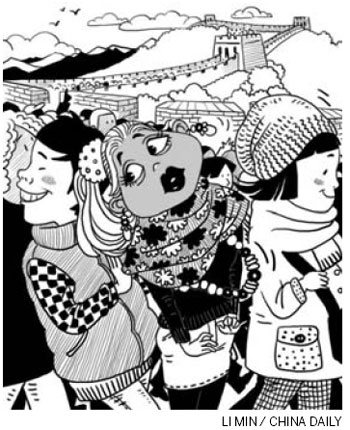Life and Leisure
Transported back in time by the Wall at Badaling
By Chitralekha Basu (China Daily)
Updated: 2010-11-17 07:59
 |
Large Medium Small |
Do you like crowds? Do you dig the feel of getting pasted against cold metal in the Beijing subway in rush-hour traffic? Does the fact that the parks, malls, flea markets and pavements outside school compounds at 4 in the afternoon in Beijing are overflowing with people, turn you on?
While for some of my expatriate friends from Scandinavian countries or the sparsely-populated states on the west coast of the United States the concentration of people in Beijing is a novelty, even an opportunity to have a brush with "real people" and pick up a few "survival strategies", I am not so impressed by the crowds in Beijing.
Coming from a city that's just one 16th of Beijing's size but only 4 million short of Beijing's population, I am used to goose-stepping over people sleeping on pavements and dodging the hooded scooters (we call them auto-rickshaws in India) with passengers sticking out of them like candied berries fanning out in all sorts of incredible directions. Beijing will have to get its act together and borrow people from across half of China to compete with my hometown, Kolkata, in terms of population density.

On Oct 1, the visitor turnout at the Forbidden City is said to have crossed the 100,000 mark. A fortnight later, the same number of people passed through Maddox Square, one of the trendiest venues, where Kolkata's annual autumnal festival is held. The difference is that Maddox Square is less than the size of a standard soccer field, and drew around 90,000 people between 6 pm and midnight.
Personally, I am not enamored by the idea of bobbing and floating in a sea of human heads. And in Beijing I feel a lot less asphyxiated or pushed around when I am walking the streets than I would back home. I love going on long walks along Chang'an Avenue or Beijing's north-south axis, from the Olympic Forest Park, down Gulou Waidajie and Di'anmen Waidajie and up the artificial hillock in Jingshan Park, to gaze over the miles of red-tiled roofs of the Forbidden City.
I feel grateful that I can drop my guard and not have to worry constantly about being rammed against the wave of people surging forward from the opposite side.
I turned into a walk-aholic soon after arriving in Beijing. The sprawling parks, neat, whole pavements and not having to routinely bump into strangers made a winning combo. In fact, you could also call me a Wall-aholic. I have a pathological urge to scale heights, even if I have to huff and puff most of the way. And what better way to do it than from Beijing, which gives access to at least eight different climb-worthy sections of the Great Wall in its vicinity, each replete with a distinct character and features.
I have been to the Wall several times, to different sections in different seasons. But I had ignored Badaling, as it was supposedly the most touristy of the lot.
I went there recently with a cousin who was visiting. As we entered the base area, the ramps winding down from the watchtowers had turned into a flowing mosaic of red, white, black and blue - multi-hued winter-gear, glowing against the crystalline blue sky.
The stairs snaked up at impossible angles, but it was totally accident-proof. Even if you slipped or missed a step, there would be a tight-knit cushion of human backs, before and after, to keep you out of harm's way. The concentration of people intensified as one climbed higher.
The only way of getting to the top, it seemed, was to plunge headlong into the mass of pullovers, windcheaters and down jackets, and burrow one's way in, dodging the hyper-active peddlers trying to thrust picture postcards, collapsible straw hats and dubious certificates congratulating the panting, heaving, pack of unaccustomed climbers for "making it" to the top.
Felt like home. Finally.
China Daily
